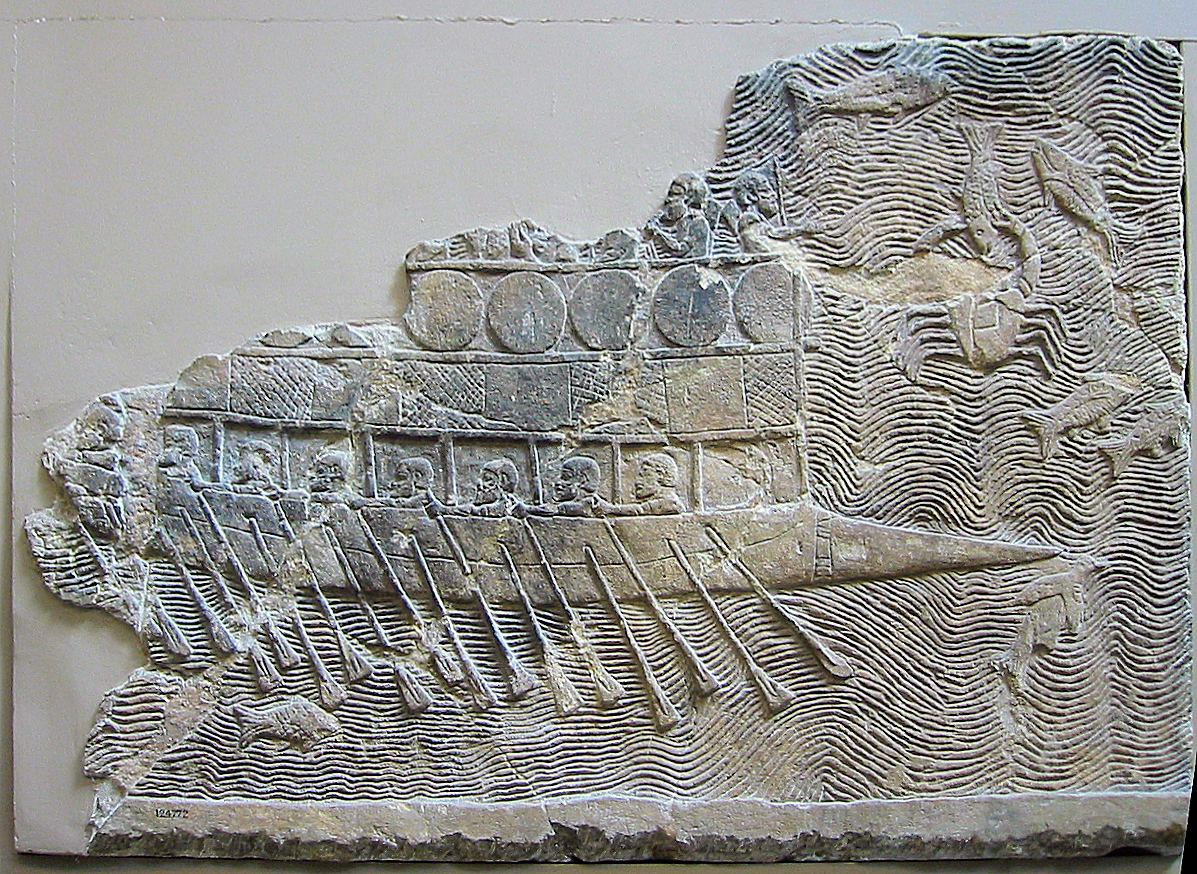Bireme on:
[Wikipedia]
[Google]
[Amazon]
A bireme (, ) is an ancient oared warship (

galley
A galley is a type of ship optimised for propulsion by oars. Galleys were historically used for naval warfare, warfare, Maritime transport, trade, and piracy mostly in the seas surrounding Europe. It developed in the Mediterranean world during ...
) with two superimposed rows of oars on each side. Biremes were long vessels built for military purposes and could achieve relatively high speed. They were invented well before the 6th century BC and were used by the Phoenicia
Phoenicians were an Ancient Semitic-speaking peoples, ancient Semitic group of people who lived in the Phoenician city-states along a coastal strip in the Levant region of the eastern Mediterranean, primarily modern Lebanon and the Syria, Syrian ...
ns, Assyrians, and Greeks.


Description
The name bireme comes from "bi-" meaning two and "-reme" meaning oar. It was typically about long with a maximum beam width of around . It was modified from the penteconter, a ship that had only one set of oars on each side, the bireme having two sets of oars on each side. The bireme was twice the triaconter's length and height, and thus employed 120 rowers. Biremes weregalley
A galley is a type of ship optimised for propulsion by oars. Galleys were historically used for naval warfare, warfare, Maritime transport, trade, and piracy mostly in the seas surrounding Europe. It developed in the Mediterranean world during ...
s, galleasses, dromons, and small pleasure crafts called pamphyles.
The next development, the trireme
A trireme ( ; ; cf. ) was an ancient navies and vessels, ancient vessel and a type of galley that was used by the ancient maritime civilizations of the Mediterranean Sea, especially the Phoenicians, ancient Greece, ancient Greeks and ancient R ...
, keeping the length of the bireme, added a tier to the height, the rowers being thus increased to 180. It also had a large square sail.
Uses
These ships were frequently used by the Romans, as during the second ofCaesar's invasions of Britain
In the course of his Gallic Wars, Julius Caesar invaded Britain twice: in 55 and 54 BC. On the first occasion, Caesar took with him only two legions, and achieved little beyond a landing on the coast of Kent. The second invasion was more subst ...
. The bireme eventually evolved into the trireme
A trireme ( ; ; cf. ) was an ancient navies and vessels, ancient vessel and a type of galley that was used by the ancient maritime civilizations of the Mediterranean Sea, especially the Phoenicians, ancient Greece, ancient Greeks and ancient R ...
. A unit commandant (who was given a tent on the open deck) directed a group of marines. The bireme was also recorded in ancient history on the 8th and early 7th-century BC Assyrian reliefs, where they were used to carry out an amphibious attack on the coast of Elam and the lagoons of the Persian Gulf during the reign of Sennacherib
Sennacherib ( or , meaning "Sin (mythology), Sîn has replaced the brothers") was the king of the Neo-Assyrian Empire from 705BC until his assassination in 681BC. The second king of the Sargonid dynasty, Sennacherib is one of the most famous A ...
.
Medieval galleys are also described as "bireme" or "trireme" depending on the number of their banks of oars. The terminology can lead to confusion, since the terms are also used for rowed warships of the Greco-Roman period built on entirely different design principles.
Dimensions and development
In 1275,Charles of Anjou
Charles I (early 1226/12277 January 1285), commonly called Charles of Anjou or Charles d'Anjou, was King of Sicily from 1266 to 1285. He was a member of the royal Capetian dynasty and the founder of the House of Anjou-Sicily. Between 1246 a ...
, king of Sicily
Sicily (Italian language, Italian and ), officially the Sicilian Region (), is an island in the central Mediterranean Sea, south of the Italian Peninsula in continental Europe and is one of the 20 regions of Italy, regions of Italy. With 4. ...
, issued an order for the construction of several galleys that provide the earliest evidence for the dimensions of the bireme galleys. Because of increased weight and breadth, which brought increased friction through the water, a trireme galley was not dramatically faster than a bireme. But the change to trireme produced more significant developments than a gain in tactical speed over short distances. Early bireme galleys escorted merchant ships but were rarely used to carry goods. A few Genoese freight contracts of the mid-13th century record charters for bireme galleys.
See also
* ''Ivlia'' (ship)References
{{Ancient seafaring Ships of ancient Greece Navy of ancient Rome Galleys Naval warfare of antiquity Transport in Phoenicia